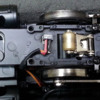Here's a new way to generate the chuffs for TMCC upgrades and older TMCC locomotives where you want 4 chuffs/rev.
I had this Lionel Cab Forward for upgrade with the Super-Chuffer, and part of the upgrade was 4-chuffs. The drivers are so close that I couldn't mount the magnets there, and the recess for the wheels is barely visible around the frame, so sticking them in there was going to be REALLY difficult. The wheels recess was also very deep, so the magnets would have to be sort of "floating" on the rim, making it even harder.
I decided to mount them on the leading pilot truck, the trailing truck didn't have room for the magnet. That might have worked, but on corners and any sort of uneven spot on the track, the wheels wouldn't always rotate, so you'd skip chuffs. Not acceptable! I tinkered with the springs on the pilot truck, but I couldn't get it right.
Time for a totally fresh approach. I ordered some reflective optical sensors and set about doing this optically. It turned out to be easier than I thought. I cleaned the inside of the wheel and stuck small squares of silver tape every 90 degrees, and then bonded the sensor to the frame. A couple of resistors, one for load and one to limit the LED driver current, and everything connects to the Super-Chuffer, which already supplies the 5VDC power needed.
This may become a standard feature of my upgrades, it's much less likely to double triggering like the reed switch with magnets. Unless you position the reed switch just right, it can get a "double-tap" as the magnet goes by.






